Living in Central Virginia at the foot of the Appalachian Mountain, specifically the Blue Ridge physiographic province, I find myself in the middle of God’s country. I know…that label gets used quite a bit to describe various parts of the United States of America, and with good cause. Well, the George Washington National Forest and the Shenandoah National Park are rimmed with various wildlife management areas (WMA) that are ripe with mountain streams, timber cut fields, and hiking trails. The Appalachian Trail cuts a winding path through my backyard playground, and during the fall, it becomes my highway for game hunting. I do also enjoy the relatively flat land hunting further away from the foot hills and Blue Ridge. However, being the type of outdoorsman that enjoys a good hike with the high altitude scenery and challenge that goes with that type of terrain, I find myself doing more hunting up in the Blue Ridge than anywhere else. The number one challenge faced by those hunters that find themselves in vertical terrain is kit weight. The second, although not entirely necessary, is long range accuracy. Weight is evident. Anything you carry into the hunt has to go up the mountain. If you are lucky enough to harvest your quarry, then you have quite a bit of additional weight to get back out. There are no provisions for ATVs in this type of hunting since the National Forest Service has banned them, at least where I am referring to. Accuracy is a plus if you glass a Boone and Crockett deer or acceptable black bear across the valley on the next peak over. While most shots are inside 100 yards and a 30-30 brush gun would be more than sufficient, some longer range shots do present themselves. Those two points, and the fact that I tired myself out needlessly last season carrying a behemoth rifle, helped me make my decision to go light weight this year. But, I still wanted to retain the inherent accuracy of the types of rifles I tend to be drawn to. The ability to have a dual role hunter/paper puncher/steel ringer was the real basis for my project.
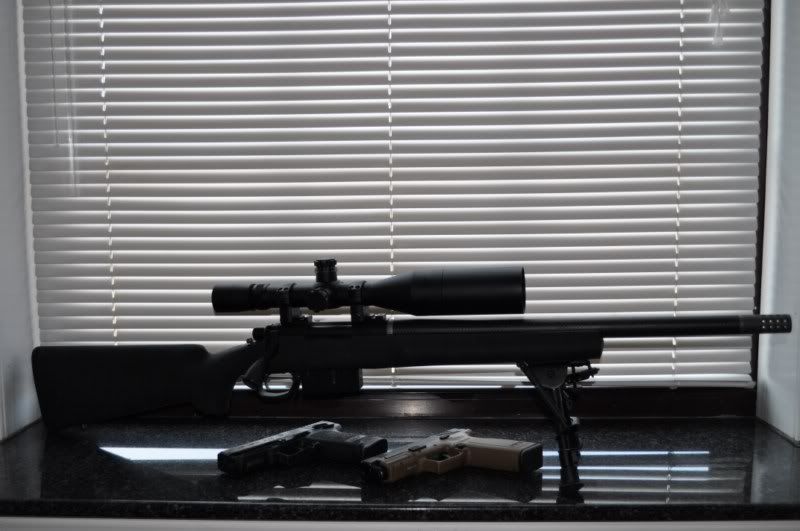
This project, as all my projects do, preceded with a lot of research. First, what caliber to choose? Well, I’m very accustomed to the .308 Winchester, as far as ballistics go, this cartridge is perfect for all the animals I would hunt in North America with maybe the exception of ethically bringing down a long-range elk. The .308 Win is an inherently accurate round at moderate hunting ranges with plenty of energy for white tail and average black bear, which are the two main targets on my mind. With a vast selection of bullet weights and shapes, the .308 is a versatile round and would fit the bill for this project. The other big advantage for me would be compatibility with my dopes that I have been working on over the last year or so.
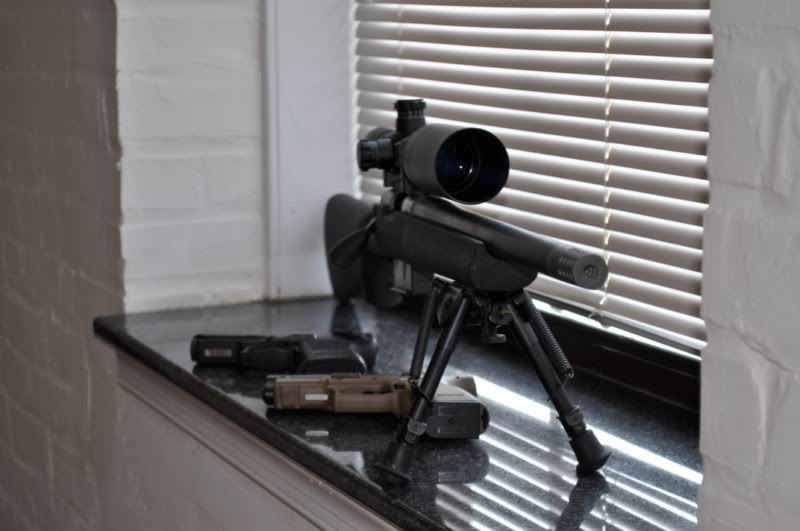
Second question to be answered: do I custom build or buy a turn-key rifle? Well, I talked to several barrel makers out there that made some interesting recommendations to me for reducing weight. Going with a sporter light weight barrel wasn’t going to be an option since accuracy was going to be a requirement. Many a thin walled sporter barrel will have trouble maintaining even 1 MOA, so those 400 yard shots from ridge to ridge would be an automatic abort. Sporter barrels also tend to have varying degrees of Pointe-Of-Impact (POI) shift from cold bore to hot bore temperature ranges. This can make zeroing for longer distances a futile exercise. The more accurate the rifle and the more proficient the shooter, the longer the shot can be and still be considered ethical. The dilemma went back to weight savings, but with a heavy barrel that would hold better accuracy and less POI shift relative to barrel temperature. The options came down to short barrel length, fluting, or a combination of the two. I’m familiar with heavy barrels, as I was already in possession of a very heavy stainless steel 24” bull barrel that I utilized for target shooting. Remember the heavy thing I referred to earlier that I lugged around the mountains last season? But, even having a custom cut-down 18” or 20” heavy bull barrel was going to be heavier than my goal for this project. I decided that I liked the accuracy of my 24” mil-spec barrel with 1:11.25 twist and that I would prefer to use it for the basis of the project. While talking to Mike at Rock Creek Barrels in Wisconsin, he told me about a company profiling heavy barrels down to reduce mass and then wrapping them back up in carbon to regain strength while lightening them up. The other benefit gained by this process is that the carbon also stiffens the barrel more than the original steel. Two companies were pointed out to me. ABS, or Advanced Barrel Systems, and Christensen Arms. It just so happens that Christensen Arms makes turn-key light-weight mountain rifles. Imagine that! I looked at their Carbon One rifle and decided that my project would follow that pattern, but it would cost me significantly less due to me already owning an accurate matched Remington M700 stainless receiver and the mil-spec barrel that could be used as the blank. I got my ducks in a row and got on with the project. The barrel work would put the rifle out of commission for several months.

Christensen basically profiles down the provided barrel and re-profiles it back up to your specification in carbon to whatever profile you select. I wanted the same #8 heavy contour that I was sending them. This contour works good in a free-float stock. The weight savings in the barrel, without compromising stiffness and accuracy, can be measured in pounds, not ounces. This allowed me to maintain some other slightly heavier components that are considered tactical rugged versus replacing them with light weight components that compromised durability. Hours of hiking up and down the mountain with a short 18” carbon barrel carbon will now be much more comfortable. I decided to have them cut it down to 18” and thread the end to accept a suppressor and muzzle brake. I ordered CA’s titanium removable brake and started looking into AWC Thundertrap suppressors which are legal to hunt with in VA. CA was also going to provide a muzzle cap to protect the threads if I decided to hunt without the brake. The idea of the brake was to tame the added recoil felt from a shortened barrel when not utilizing the suppressor can.
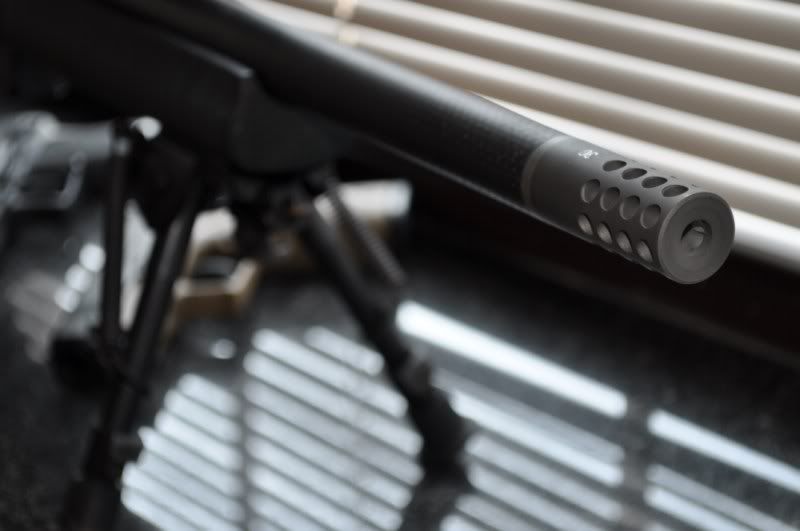
The Remington short action stainless steel M700 receiver was already matched to this barrel, so there wasn’t anything to be done there. The receiver is heavy, but I didn’t want to go light in the receiver.
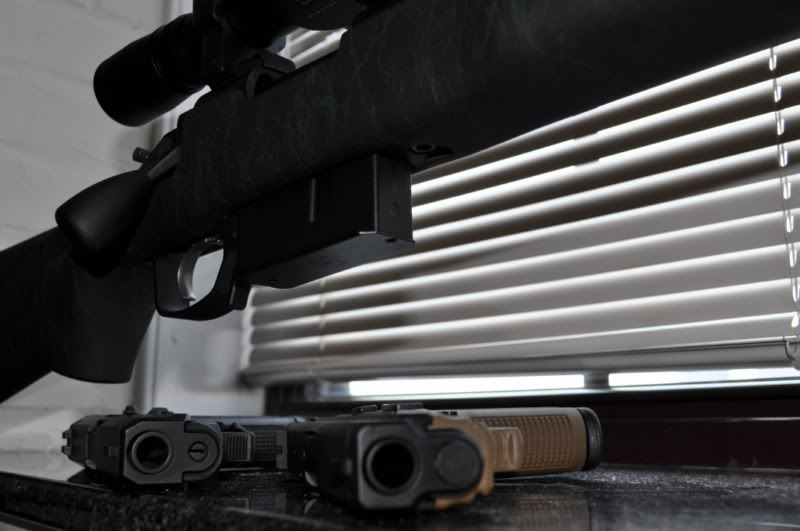
I was able to utilize the HS Precision stock that the M700 and mil-spec barrel originally came in. While it’s not the lightest weight stock, it is composite and falls somewhere between a synthetic plastic stock and a wood stock in that regard. The increased palm swell makes shooting this rifle off hand or on a bench bag very comfortable and stable with no unauthorized canting destroying long range firing solutions by throwing off your reticle to barrel alignment. The ultimate in light weight would be a carbon stock by Christensen Arms; however, the recoil even of a tame .308 would soon be felt if a range day was in order and a lot of shots down range were fired. And, the cost for that all carbon stock is ridiculously expensive. I felt the HS Precision stock was a good compromise between hunting practicality and tactical precision.
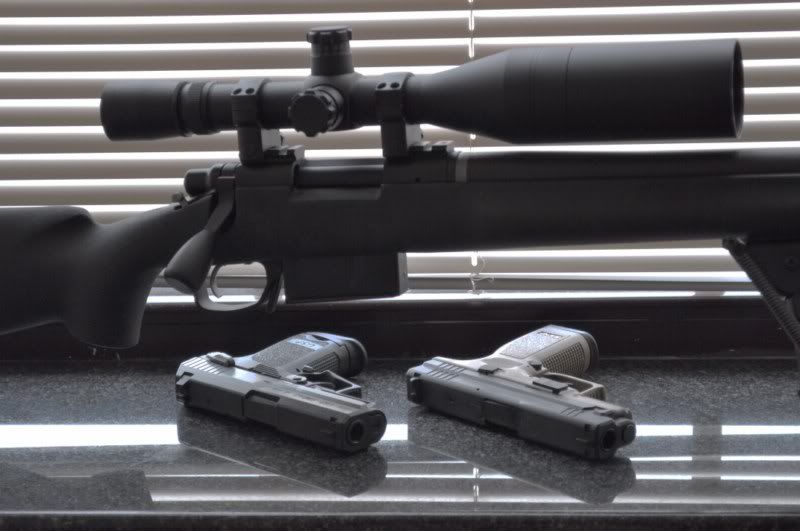
While the barrel was out for work at Christensen Arms, I sent the stock off to CDI Precision to have it inletted and a drop box magazine well installed. A DBM replaces the internal magazine and bottom metal with something that is very useful in my mind. My other rifle stock is an Accuracy International Chassis System that utilizes a DBM as well and 5 or 10 round magazines. The AI magazines are some of the best in the industry, and it was tempting to be able to use the same magazines no matter which rifle I grabbed from the safe. CDI’s DBM utilizes the AI magazines, and their work comes highly recommended in the tactical community. Jeff at CDI did a great job on the stock and had it back to me within two weeks door to door. I now have a 5 round magazine for hunting and a 10 rounder for paper/steel work.
While my barrel was out, I decided that I would send CA my bolt and have them install a new larger bolt knob. Working a standard Remington bolt knob, even without gloved hands, is considered a chore. It’s just too small and strangely shaped to be comfortable. They did a great job, and when it came back, I had my local gun smith Cerkote the receiver and bolt black. I have never utilized Cerkote in the past, and quite frankly, I probably would choose to have the metal sent off to Birdsong and Associates for Black-T finishing instead. The Cerkote, while thinner than Duracoat, which I wanted for the bolt, doesn’t seem to be as robust. I’m sure I’ll be re-applying a finish in the future. The Birdsong Black-T finish is not a paint, but a molecularly bonded finish that actually impregnates the metal so that even if the color is worn off, the metal is still protected. While both the Black-T and the Cerkote are considered self-lubricating, I can see the difference in the quality of finishes. The Cerkote on the bolt and receiver required some light lapping to get a smooth friction free action. I applied some Hoppe’s #9 mixed with some gun oil to the bolt and cycled the action several hundred times. It is now as smooth as butter.
Upon receipt of all components, my gunsmith tuned the Remington X-Mark trigger down to 2.5 pounds and assembled the rifle for me making sure everything was trued and torque properly. The optics package is all Leupold. I used two-piece Mk-IV bases and Mk-IV rings. The scope is a Mk-IV LR/T 4.5-14 x 50 with M1 knobs and Leupold’s Tactical Milling Reticle (TMR). The M1 knobs give ¼ inch adjustments for both elevation and windage. Total elevation adjustment in this scope will allow for 308 long range shooting without a 20 MOA base. The TMR reticle is an offshoot of the Mil-Dot reticle used by both the Army and the Marine Corps. While both of their Mil-Dots are slightly different in size, the TMR uses fine hashes for precise measurement and ranging. I carry a Leupold RX-III laser range finder, but the ability to range using the TMR comes in handy when quarry presents itself before a range card can be measured and drawn up.
I utilize a Harris bi-pod with this rifle and a M24 tactical sling with bicep cuff. The Harris is lightweight, has ratcheting legs to lock in varying amounts of length for uneven ground shooting, and is stiff enough to allow me to load it up prior to pulling the trigger. The Tactical Intervention M24 sling makes stabilizing the rifle much easier for off-hand or prone shooting with a rest or bi-pod.
I’ll be doing a range evaluation of this rifle come mid-September. I’ll be utilizing factory Federal SMK 175 for target, and factory Federal Barnes TSX 168 for hunting. I’ll plan on recording 5-shot groups at 100 yards and 300 yards in the first evaluation. Once I have base-line data for the factory ammunition, I’ll start developing hand-loads to improve on accuracy.
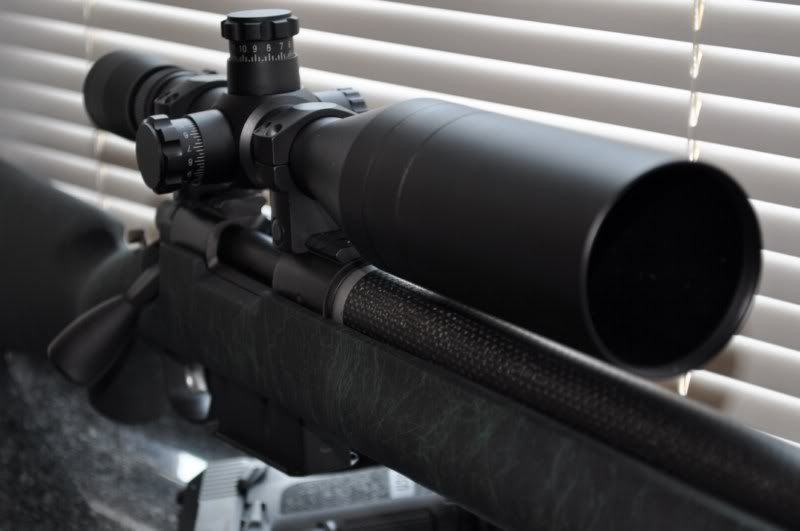
On a note about carbon barrels: I am coming off the starting line expecting this barrel to be less accurate than it started out. While manufacturer claims of carbon accuracy seem a little inflated, I realize that I’m reducing muzzle and down-range velocities by about 10 fps per inch in barrel reduction. That equates to about 60 fps loss from the start barrel to the end barrel. The stiffness of the barrel has been increased about 5%. I plan on using a chronograph to get accurate feedback on the barrel, and the accuracy will most likely reflect more on the shooter than on the barrel. I claim only to be an informed and educated amateur long-range shooter, so we’ll see how I do with this new tool. I will only post 5-shot groups and identify the cold-bore shot for each.
I hope you have enjoyed my project build. If you have any questions, feel free to ask and I’ll answer what I can.

Update:
OK, I decided to take the carbon 700 to the range today. I've been on a 30-day assignment and just got back last night. I needed to zero the scope first. I picked up some cheap Remington Core-Lok hunting ammo to make sure I was on paper. I just bagged the rifle, pulled the bolt, and matched up the reticle with the bore picture using a target at 25 yards. One shot put a 150-grain on the paper. I adjusted the elevation and windage for .75 inches low and put another round in the bullseye. I then put a target at 100 yards and fine tuned the zero still using the crappy ammo. Then I switched over to Federal GMM SMK 175's and adjusted zero and let them rip. I shot the first two groups prone off the bipod and the rear bagged. The cold bore shot was after a 30 minute cool off from the 150's at 100. The second group was about the same. I decided to bag the whole rifle and shoot from a more stable rest. I put the next 5-round group in a .525 grouping. I used to shoot this barrel when it was 24" long with no CF at .5" all day long. I'm happy with .525 and I'm sure with my handloads, I'll break .5 MOA. CF does not affect accuracy, and this was after shortening the barrel to 18" from 24" and with a heated barrel.


I'm very happy with this CF conversion. It started out as a compromise between accuracy and weight. I've realized that accuracy was not necessarily compromised at all. It seems to be shooting quite well, or at least to the shooter's capability. I'll call this project a success.
And while the rifle was being finished, so was my duty 1911. She just came back from Walter Birdsong for her FBI HRT two-tone finish.
http://i776.photobucket.com/albums/yy46/Room055/DSC_0002.jpg
http://i776.photobucket.com/albums/yy46/Room055/DSC_0001.jpg
Is it legal to hijack your own post? LOL

This project, as all my projects do, preceded with a lot of research. First, what caliber to choose? Well, I’m very accustomed to the .308 Winchester, as far as ballistics go, this cartridge is perfect for all the animals I would hunt in North America with maybe the exception of ethically bringing down a long-range elk. The .308 Win is an inherently accurate round at moderate hunting ranges with plenty of energy for white tail and average black bear, which are the two main targets on my mind. With a vast selection of bullet weights and shapes, the .308 is a versatile round and would fit the bill for this project. The other big advantage for me would be compatibility with my dopes that I have been working on over the last year or so.

Second question to be answered: do I custom build or buy a turn-key rifle? Well, I talked to several barrel makers out there that made some interesting recommendations to me for reducing weight. Going with a sporter light weight barrel wasn’t going to be an option since accuracy was going to be a requirement. Many a thin walled sporter barrel will have trouble maintaining even 1 MOA, so those 400 yard shots from ridge to ridge would be an automatic abort. Sporter barrels also tend to have varying degrees of Pointe-Of-Impact (POI) shift from cold bore to hot bore temperature ranges. This can make zeroing for longer distances a futile exercise. The more accurate the rifle and the more proficient the shooter, the longer the shot can be and still be considered ethical. The dilemma went back to weight savings, but with a heavy barrel that would hold better accuracy and less POI shift relative to barrel temperature. The options came down to short barrel length, fluting, or a combination of the two. I’m familiar with heavy barrels, as I was already in possession of a very heavy stainless steel 24” bull barrel that I utilized for target shooting. Remember the heavy thing I referred to earlier that I lugged around the mountains last season? But, even having a custom cut-down 18” or 20” heavy bull barrel was going to be heavier than my goal for this project. I decided that I liked the accuracy of my 24” mil-spec barrel with 1:11.25 twist and that I would prefer to use it for the basis of the project. While talking to Mike at Rock Creek Barrels in Wisconsin, he told me about a company profiling heavy barrels down to reduce mass and then wrapping them back up in carbon to regain strength while lightening them up. The other benefit gained by this process is that the carbon also stiffens the barrel more than the original steel. Two companies were pointed out to me. ABS, or Advanced Barrel Systems, and Christensen Arms. It just so happens that Christensen Arms makes turn-key light-weight mountain rifles. Imagine that! I looked at their Carbon One rifle and decided that my project would follow that pattern, but it would cost me significantly less due to me already owning an accurate matched Remington M700 stainless receiver and the mil-spec barrel that could be used as the blank. I got my ducks in a row and got on with the project. The barrel work would put the rifle out of commission for several months.

Christensen basically profiles down the provided barrel and re-profiles it back up to your specification in carbon to whatever profile you select. I wanted the same #8 heavy contour that I was sending them. This contour works good in a free-float stock. The weight savings in the barrel, without compromising stiffness and accuracy, can be measured in pounds, not ounces. This allowed me to maintain some other slightly heavier components that are considered tactical rugged versus replacing them with light weight components that compromised durability. Hours of hiking up and down the mountain with a short 18” carbon barrel carbon will now be much more comfortable. I decided to have them cut it down to 18” and thread the end to accept a suppressor and muzzle brake. I ordered CA’s titanium removable brake and started looking into AWC Thundertrap suppressors which are legal to hunt with in VA. CA was also going to provide a muzzle cap to protect the threads if I decided to hunt without the brake. The idea of the brake was to tame the added recoil felt from a shortened barrel when not utilizing the suppressor can.

The Remington short action stainless steel M700 receiver was already matched to this barrel, so there wasn’t anything to be done there. The receiver is heavy, but I didn’t want to go light in the receiver.

I was able to utilize the HS Precision stock that the M700 and mil-spec barrel originally came in. While it’s not the lightest weight stock, it is composite and falls somewhere between a synthetic plastic stock and a wood stock in that regard. The increased palm swell makes shooting this rifle off hand or on a bench bag very comfortable and stable with no unauthorized canting destroying long range firing solutions by throwing off your reticle to barrel alignment. The ultimate in light weight would be a carbon stock by Christensen Arms; however, the recoil even of a tame .308 would soon be felt if a range day was in order and a lot of shots down range were fired. And, the cost for that all carbon stock is ridiculously expensive. I felt the HS Precision stock was a good compromise between hunting practicality and tactical precision.

While the barrel was out for work at Christensen Arms, I sent the stock off to CDI Precision to have it inletted and a drop box magazine well installed. A DBM replaces the internal magazine and bottom metal with something that is very useful in my mind. My other rifle stock is an Accuracy International Chassis System that utilizes a DBM as well and 5 or 10 round magazines. The AI magazines are some of the best in the industry, and it was tempting to be able to use the same magazines no matter which rifle I grabbed from the safe. CDI’s DBM utilizes the AI magazines, and their work comes highly recommended in the tactical community. Jeff at CDI did a great job on the stock and had it back to me within two weeks door to door. I now have a 5 round magazine for hunting and a 10 rounder for paper/steel work.
While my barrel was out, I decided that I would send CA my bolt and have them install a new larger bolt knob. Working a standard Remington bolt knob, even without gloved hands, is considered a chore. It’s just too small and strangely shaped to be comfortable. They did a great job, and when it came back, I had my local gun smith Cerkote the receiver and bolt black. I have never utilized Cerkote in the past, and quite frankly, I probably would choose to have the metal sent off to Birdsong and Associates for Black-T finishing instead. The Cerkote, while thinner than Duracoat, which I wanted for the bolt, doesn’t seem to be as robust. I’m sure I’ll be re-applying a finish in the future. The Birdsong Black-T finish is not a paint, but a molecularly bonded finish that actually impregnates the metal so that even if the color is worn off, the metal is still protected. While both the Black-T and the Cerkote are considered self-lubricating, I can see the difference in the quality of finishes. The Cerkote on the bolt and receiver required some light lapping to get a smooth friction free action. I applied some Hoppe’s #9 mixed with some gun oil to the bolt and cycled the action several hundred times. It is now as smooth as butter.
Upon receipt of all components, my gunsmith tuned the Remington X-Mark trigger down to 2.5 pounds and assembled the rifle for me making sure everything was trued and torque properly. The optics package is all Leupold. I used two-piece Mk-IV bases and Mk-IV rings. The scope is a Mk-IV LR/T 4.5-14 x 50 with M1 knobs and Leupold’s Tactical Milling Reticle (TMR). The M1 knobs give ¼ inch adjustments for both elevation and windage. Total elevation adjustment in this scope will allow for 308 long range shooting without a 20 MOA base. The TMR reticle is an offshoot of the Mil-Dot reticle used by both the Army and the Marine Corps. While both of their Mil-Dots are slightly different in size, the TMR uses fine hashes for precise measurement and ranging. I carry a Leupold RX-III laser range finder, but the ability to range using the TMR comes in handy when quarry presents itself before a range card can be measured and drawn up.
I utilize a Harris bi-pod with this rifle and a M24 tactical sling with bicep cuff. The Harris is lightweight, has ratcheting legs to lock in varying amounts of length for uneven ground shooting, and is stiff enough to allow me to load it up prior to pulling the trigger. The Tactical Intervention M24 sling makes stabilizing the rifle much easier for off-hand or prone shooting with a rest or bi-pod.
I’ll be doing a range evaluation of this rifle come mid-September. I’ll be utilizing factory Federal SMK 175 for target, and factory Federal Barnes TSX 168 for hunting. I’ll plan on recording 5-shot groups at 100 yards and 300 yards in the first evaluation. Once I have base-line data for the factory ammunition, I’ll start developing hand-loads to improve on accuracy.

On a note about carbon barrels: I am coming off the starting line expecting this barrel to be less accurate than it started out. While manufacturer claims of carbon accuracy seem a little inflated, I realize that I’m reducing muzzle and down-range velocities by about 10 fps per inch in barrel reduction. That equates to about 60 fps loss from the start barrel to the end barrel. The stiffness of the barrel has been increased about 5%. I plan on using a chronograph to get accurate feedback on the barrel, and the accuracy will most likely reflect more on the shooter than on the barrel. I claim only to be an informed and educated amateur long-range shooter, so we’ll see how I do with this new tool. I will only post 5-shot groups and identify the cold-bore shot for each.
I hope you have enjoyed my project build. If you have any questions, feel free to ask and I’ll answer what I can.

Update:
OK, I decided to take the carbon 700 to the range today. I've been on a 30-day assignment and just got back last night. I needed to zero the scope first. I picked up some cheap Remington Core-Lok hunting ammo to make sure I was on paper. I just bagged the rifle, pulled the bolt, and matched up the reticle with the bore picture using a target at 25 yards. One shot put a 150-grain on the paper. I adjusted the elevation and windage for .75 inches low and put another round in the bullseye. I then put a target at 100 yards and fine tuned the zero still using the crappy ammo. Then I switched over to Federal GMM SMK 175's and adjusted zero and let them rip. I shot the first two groups prone off the bipod and the rear bagged. The cold bore shot was after a 30 minute cool off from the 150's at 100. The second group was about the same. I decided to bag the whole rifle and shoot from a more stable rest. I put the next 5-round group in a .525 grouping. I used to shoot this barrel when it was 24" long with no CF at .5" all day long. I'm happy with .525 and I'm sure with my handloads, I'll break .5 MOA. CF does not affect accuracy, and this was after shortening the barrel to 18" from 24" and with a heated barrel.


I'm very happy with this CF conversion. It started out as a compromise between accuracy and weight. I've realized that accuracy was not necessarily compromised at all. It seems to be shooting quite well, or at least to the shooter's capability. I'll call this project a success.
And while the rifle was being finished, so was my duty 1911. She just came back from Walter Birdsong for her FBI HRT two-tone finish.
http://i776.photobucket.com/albums/yy46/Room055/DSC_0002.jpg
http://i776.photobucket.com/albums/yy46/Room055/DSC_0001.jpg
Is it legal to hijack your own post? LOL

